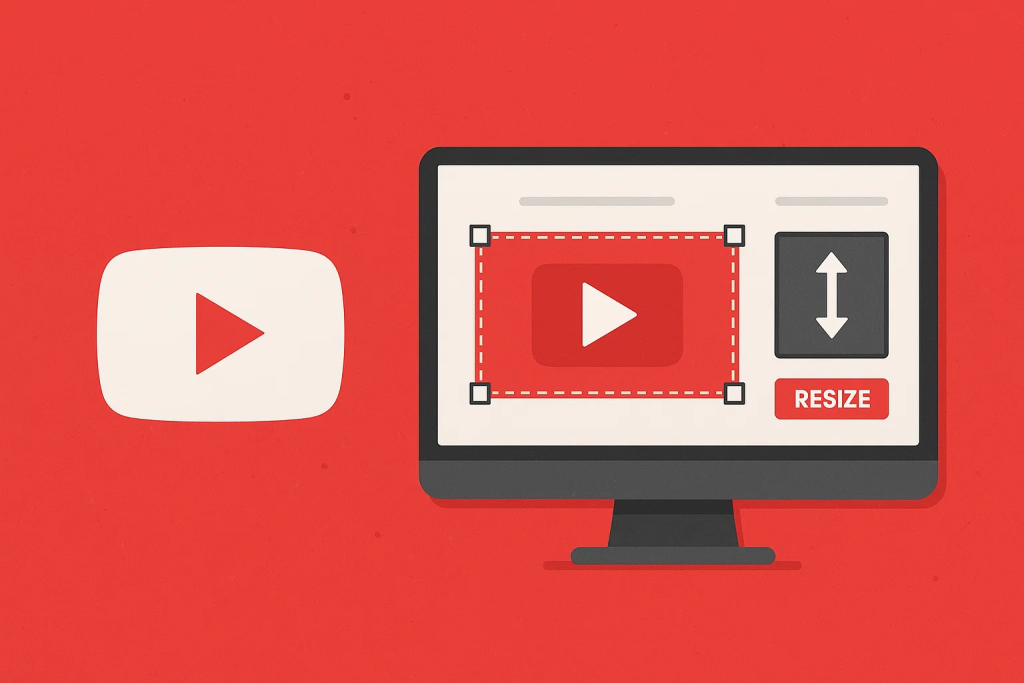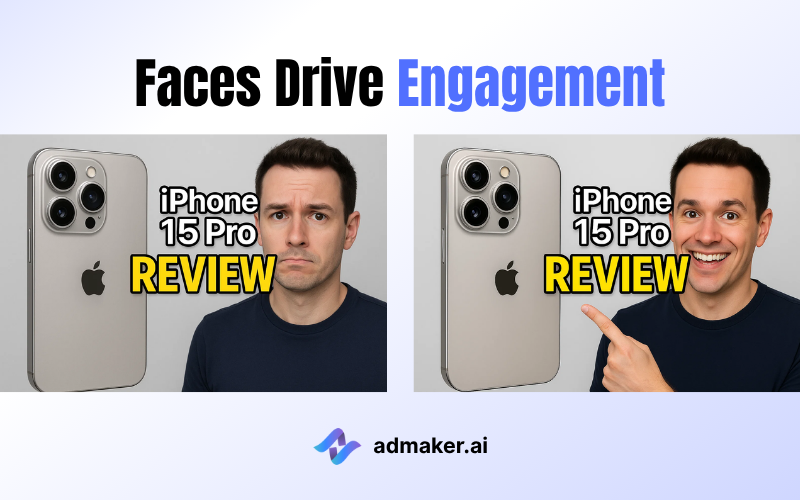Let’s talk thumbnails. The make-or-break element that determines whether someone clicks on your YouTube video or scrolls right past it.
I’ve watched countless creators struggle in optimizing YouTube content and the technical side of thumbnail creation. Getting a decent thumbnail for YouTuber isn’t just about meeting platform requirements, it’s about understanding how your thumbnail will appear across different devices and can actually drive clicks.
Whether you’re just starting your YouTube journey or you’re looking to improve your existing content performance, mastering the size of YouTube thumbnail specifications will give you a significant edge in the competitive world of video content.
Standard Size of YouTube Thumbnail
First things first: YouTube thumbnail size should be exactly 1280 pixels wide by 720 pixels tall. This 16:9 aspect ratio has remained consistent, and for good reason – it works beautifully across every viewing platform.
| Display Type | Thumbnail Dimensions | Aspect Ratio |
|---|---|---|
| Desktop Display | 1280 × 720 px | 16:9 |
| Tablet Display | 1280 × 720 px | 16:9 |
| Mobile Display | 1280 × 720 px | 16:9 |
| TV Display | 1280 × 720 px | 16:9 |

What Actually Matters for Your Thumbnails
Apart from the basic dimensions, there are some technical requirements essential to your thumbnail upload:
- File formats: JPG, PNG, GIF, or BMP (though JPG typically gives you the best balance of quality and file size)
- File size limits: Stay under 2MB for regular videos, 10MB for podcast content
- Resolution sweet spot: 72 PPI minimum, but aim higher if you can
- The golden ratio: That 16:9 aspect ratio isn’t negotiable
Some creators don’t realize that while the yt thumbnail size stays consistent across devices, how much of your thumbnail actually gets seen can vary dramatically. Mobile users might see your thumbnail at a fraction of desktop size, which is why testing your designs at different scales becomes crucial. So the key is designing with the smallest viewing size in mind first.
Standard Size of YouTube Banner
The channel banner operates on completely different rules from the thumbnail. The recommended YouTube banner size is 2560 × 1440 pixels, but different devices crop this image differently.
| Display Type | Banner Visible Area | Safe Zone |
|---|---|---|
| Desktop Display | 2560 × 423 px | 1546 × 423 px |
| Tablet Display | 1855 × 423 px | 1546 × 423 px |
| Mobile Display | 1546 × 423 px | 1546 × 423 px |
| TV Display | 2560 × 1440 px | 2560 × 1440 px |

The Reality of Banner Design
Your banner file can be up to 6MB, and while you can use either JPG or PNG.
There is a so-called “safe area” of 1235 × 338 pixels, which we usually present the key elements here. And always design mobile-first. If your banner works on the smallest safe zone, it’ll work everywhere else.
How to Create a YouTube Thumbnail with Admaker
Creating thumbnails doesn’t have to be complicated, but it does require understanding what makes people click. Here’s how I approach it using Admaker:
Start with the Right Foundation When you open Admaker’s YouTube thumbnail template, you’re already working with the correct dimensions. This eliminates the guesswork and lets you focus on what really matters – creating compelling visual content.
Design for Impact, Not Perfection The biggest mistake I see creators make is overthinking their thumbnail design. Your goal isn’t to win a design award; it’s to stop someone from scrolling and make them curious enough to click.
Upload high-contrast images that pop against YouTube’s white background. If you’re featuring people in your thumbnails, make sure their expressions are clear and engaging – surprised, excited, or intrigued faces consistently outperform neutral expressions.
Test Your Text Readability Before you finalize any design, shrink it down to about the size of a postage stamp. If you can’t read your text at that size, neither can mobile users. Keep your fonts bold, your message short, and your contrast high.
Brand Consistency Pays Off Develop a visual style that makes your thumbnails instantly recognizable. This doesn’t mean every thumbnail should look identical, but consistent color schemes, font choices, and layout patterns help build channel recognition over time.
The thumbnail maker tools in Admaker handle the technical requirements automatically, letting you experiment with different approaches until you find what resonates with your audience.
How to Change a YouTube Thumbnail Image
Updating thumbnails can dramatically improve your video performance, but there are some requirements to keep in mind. Here’s what you need to know about how to change thumbnail on youtube:
Getting Upload Privileges Not everyone can upload custom thumbnails immediately. Your channel needs to be verified with a phone number, maintain good standing with Community Guidelines, and have a clean policy record. These requirements exist for good reason – they help maintain platform quality.
The Upload Process Once you’re eligible, the actual process is straightforward. Head to YouTube Studio, find your video in the Content section, and look for the thumbnail options in the Details tab. The platform accepts the standard 1280×720 resolution with files under 2MB.
What Makes the Difference Here’s something many creators overlook: YouTube shows you a preview of how your thumbnail will look across different devices before you publish. Use this feature. What looks perfect on your computer screen might be illegible on a phone.
Performance Monitoring After updating a thumbnail, keep an eye on your click-through rates. Sometimes a change that seems like an improvement can actually hurt performance. YouTube Analytics will show you exactly how your new thumbnail is performing compared to the old one.
If you’re wondering how do i make a thumbnail on youtube that actually works, remember that thumbnails function like movie posters – they need to create intrigue and promise value in a single glance.
Resize YouTube Thumbnail Image with Admaker
Sometimes you have great source material that just needs the right dimensions. Admaker’s resizing tool takes the guesswork out of getting your images ready for YouTube.
Smart Resizing vs. Simple Cropping The difference between a good resizing tool and a basic one comes down to how it handles aspect ratio changes. When you upload an image that doesn’t match YouTube’s 16:9 ratio, you need intelligent cropping that preserves the most important parts of your image.
Quality Preservation One of the biggest concerns when resizing is maintaining image quality. Admaker’s tool uses algorithms that minimize quality loss while ensuring your final image meets YouTube’s specifications perfectly.
Preview and Adjust The real value comes from being able to see exactly how your resized image will look at actual thumbnail viewing sizes. You can adjust the crop area, enhance sharpness, and fine-tune brightness before downloading your finished thumbnail.
This approach saves you from the frustration of uploading what looks like a perfect thumbnail, only to discover it doesn’t work at smaller sizes.
Best Practices of YouTube Thumbnail
After analyzing thousands of successful YouTube thumbnails across different niches, certain patterns consistently emerge. Here’s what actually moves the needle:
Contrast Is Your Best Friend
The most successful thumbnails use colors that pop against YouTube’s interface. Bright oranges, electric blues, and vibrant reds consistently outperform muted tones. This isn’t about following design trends – it’s about basic human psychology and attention capture.
Your text needs to be readable against your background in any lighting condition. If someone’s watching YouTube on their phone in bright sunlight, they should still be able to read your thumbnail clearly.
Faces Drive Engagement
Human faces with clear emotional expressions can increase click-through rates by 30% or more. This works because our brains are hardwired to notice and respond to facial expressions. The emotion you choose should match your content – surprise for reaction videos, determination for tutorials, excitement for entertainment content.

Consistency Builds Recognition
Develop a visual signature that makes your content instantly recognizable in a crowded feed. This might be a consistent color scheme, a particular style of text treatment, or a specific layout approach. The goal is for viewers to recognize your content before they even read the title.
Perfect Examples of YouTube Thumbnail
Different content categories require different thumbnail strategies. Here’s what works across major YouTube niches:
Tech and Review Channels
The best tech channels master the art of clean, informative design. They typically feature the product prominently against a clean background, with minimal text that focuses on the key benefit or feature. Channels like Marques Brownlee excel at this approach – their thumbnails immediately communicate what product is being reviewed and hint at the verdict.

Entertainment and Gaming Content
Entertainment channels can get away with more dramatic approaches. Bold text overlays, exaggerated expressions, and high-energy color schemes work well here because the content itself is designed to entertain. The key is matching the thumbnail’s energy level to the actual content.

Educational and Business Channels
Educational content benefits from thumbnails that suggest authority and value. Clean layouts, professional imagery, and text that clearly communicates the learning outcome perform well. The goal is to make viewers feel confident they’ll gain something valuable from watching.

Standard Size of YouTube Posts
Understanding all YouTube image requirements helps maintain consistency across your entire channel presence:
| Content Type | Dimensions | Aspect Ratio | Max File Size |
|---|---|---|---|
| YouTube Thumbnail | 1280 × 720 px | 16:9 | 2MB |
| YouTube Banner | 2560 × 1440 px | 16:9 | 6MB |
| YouTube Video (4K) | 3840 × 2160 px | 16:9 | N/A |
| YouTube Profile Picture | 800 × 800 px | 1:1 | 4MB |
| YouTube Shorts Thumbnail | 1080 × 1920 px | 9:16 | 2MB |
| YouTube Community Post Image | 1200 × 675 px | 16:9 | 20MB |
These specifications are designed to ensure optimal display quality across YouTube’s various features and interfaces. Sticking to these dimensions prevents compression artifacts and ensures your content always looks professional.
Key Takeaways
Master the 1280×720 Standard
Theis dimension with 16:9 aspect ratio has been the standard for years and it works across every device and viewing context. Focus your energy on creating compelling content within these parameters rather than trying to work around them.
Mobile-First Design Philosophy
As we explained before, if your thumbnail is effective on a phone, it’ll be even more impactful on larger screens.
More important fact is, mobile devices generating an increasing majority of YouTube traffic, designing for smaller screens first ensures your thumbnails work everywhere.
Click-Through Rate Is Everything
Your thumbnail’s job is singular: get people to click. This means every design decision should be evaluated through the lens of whether it makes your video more or less clickable. Beautiful thumbnails that don’t generate clicks serve no purpose.
Stay Within Technical Limits
YouTube’s file size and format requirements exist for performance reasons. Exceeding these limits can result in rejected uploads or poor display quality, undermining all your design efforts.
FAQs
What happens if I upload the wrong thumbnail size?
YouTube will attempt to resize incorrectly sized thumbnails automatically, but this often results in poor quality, distorted images, or cropped content that makes your video look unprofessional. The platform expects the standard 1280×720 dimensions, and deviating from this almost always hurts your content’s appearance and performance.
Do YouTube Shorts use different thumbnail dimensions?
Yes, YouTube Shorts require vertical thumbnails with a 9:16 aspect ratio (1080×1920 pixels) to match the vertical video format. Using standard horizontal thumbnail dimensions for Shorts content will result in awkward cropping and poor visual presentation.
How often should I change my video thumbnails?
This depends on performance. If a video isn’t getting the clicks you expected, updating the thumbnail can sometimes provide a significant boost. However, changing thumbnails on well-performing videos can disrupt their momentum in YouTube’s algorithm, so test changes carefully and monitor results closely.
Getting your YouTube thumbnail size right is just the foundation. The real magic happens when you combine technical precision with an understanding of what makes people click. Focus on creating thumbnails that work beautifully at the standard 1280×720 dimensions while telling a compelling visual story about your content.
Remember, your thumbnail often represents the first impression viewers have of your video. Make it count.